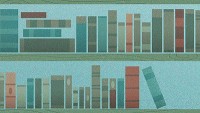An evolution-promoting author has released an illustrated children’s book, titled “Grandmother Fish,” that uses whimsical text and drawings to convince preschoolers that they are the products of evolution and the descendants of animals. “Grandmother Fish: a child’s first book of Evolution” is a 40-page children’s book written by Jonathan Tweet. The book begins by introducing its readers to a fish from whom all humans supposedly descended. “This is our Grandmother Fish,” the book’s opening line says. “She lived a long, long, long, long, long time ago.” “She could wiggle and swim fast,” the next page says. [More]
What species fall into the biblical kind for cattle? …read more Read more here: creation.com
By Ken Ham Well, first let’s strip away all the evolutionary baggage from what Keller says. Keller states in his article that ant society predated human society by 70 million years, but God’s Word makes it clear that both humans and ants were created on Day Six of Creation Week. Incredibly complex ant societies did not evolve over millions of years. Ants were created fully formed and functioning from the very beginning. The complexity of ants and their societies points towards a Designer, not millions of years of blind processes. But Keller is right in one sense—ants can teach us [More]
By CMI Several recent Creation Moments programs have featured the sounds some ants make, called stridulation. Not only do some caterpillars also make such sounds, but also they appear to communicate with some types of ants. read more …read more Read more here: Creation Moments
By Dr. Elizabeth Mitchell Karl Giberson doesn’t teach about salvation from the penalty and power of sin. He teaches we are “original sinners” as a result of our evolutionary heritage. …read more Read more here: AIG Daily
By Ken Ham Yesterday was a shock! I know we have a lot of praying people who follow me on Facebook and my blog, so this is a request to pray for our son-in-law Bodie, who is one of the writers and speakers at AiG. Yesterday, right after the Press Conference at the Ark, while media were lined up to interview me, our daughter Renee (Bodie’s wife) called me (rather distraught) to say she was rushing to the hospital as Bodie was being taken by ambulance as he appeared to be having a heart attack. That made it a bit [More]
Evolutionists cannot adequately explain why man has the ability to read. …read more Read more here: creation.com
By Troy Lacey The observational evidence of this Alaskan dinosaur graveyard fits much better with the Biblical account of the Global Flood. …read more Read more here: AIG Daily
By CMI We have mentioned a number of New World sites at which ancient Old World writing has been found. These examples, of which there are many, serve to show that before the Dark Ages, knowledge of the New World was fairly common and that man has always been curious and resourceful. read more …read more Read more here: Creation Moments
By Ken Ham Studies like this one show that climate change is a complicated set of data that needs to be interpreted. We’ve only had good data for a few years, so it’s hard to determine long term trends from a scant few years of data—and yet many climate change alarmists act as though their claims are a hard, proven science. Climate change ideas are constantly changing (just like our climate!), as the switch from using the term “global warming” to “climate change” itself shows. Climate change alarmist scientists failed to include all the parameters when they declared that Antarctic [More]
A naturalistic view of origins must explain the existence of coded information within living things arising from a ‘no mind’ process, but all of our scientific observations deny that possibility. …read more Read more here: creation.com
The 75th annual meeting of the Society of Vertebrate Paleontology provided glimpses into the latest research on fossils of all kinds, including those long-necked dinosaurs called sauropods. One presentation revealed amazing structures that demonstrated the feasibility and efficiency of design that could hold 30-foot-long necks aloft. More… …read more Read more here: icr.org
By CMI Those who believe that the universe, the Earth and everything on it are the result of mindless evolution are hard-pressed to explain the origin of intelligence. Some even try to argue that there is no such thing as intelligence, saying that we only think that certain things reflect intelligence. As we learn more about the world, it takes an ever greater faith to believe in evolution. read more …read more Read more here: Creation Moments
By Simon Turpin What Christians face today is a choice between earning the respect of the world by accepting evolution, or being faithful to Scripture. …read more Read more here: AIG Daily
Three scientists were awarded the 2015 Nobel Prize in Chemistry for uncovering how human cells repair their own DNA. DNA repair mechanisms keep us alive, and understanding them undergirds a fuller comprehension of how cells work and fend off the disastrous consequences of too many mutations. The research of these three men implies that cells have always used DNA repair mechanisms, thus uncovering evolutionary mysteries that have not yet found sensible solutions. More… …read more Read more here: icr.org
By Ken Ham Bryan described his salvation testimony for me like this: When I was about 12 years old, I went to a church and I thought I needed some “fire insurance,” so I made a commitment. But I wouldn’t say dogmatically that’s when I truly got saved. Then when I was 17 years old, I was driving down the road in a state of rebellion after church on a Wednesday night. Well, apparently family and friends were praying for me at that moment as I was driving down the road. For no apparent reason to me, I just got [More]
By Dr. Elizabeth Mitchell Despite claims they had prehistoric plumage, Ornithomimus fossils are devoid of feathers. …read more Read more here: AIG Daily
By CMI We have all heard evolutionists claim certain rocks and fossils to be millions of years old. They claim to arrive at these long ages using index fossils. Index fossils are creatures that supposedly lived during specific ages. We are told that these ages are independently verified using radiometric dating methods. But is all of this as neat and certain as evolutionists say it is? read more …read more Read more here: Creation Moments
By Ken Ham Every day at AiG, we pray, often have a short Bible study, and then give a few announcements. Recently, the entire staff gathered at the Creation Museum to hear a special speaker. Last week, we had one of the most memorable speakers in recent memory who shared his thrilling testimony with us. Samer Mohammed grew up in a Palestinian refugee camp in Lebanon and was indoctrinated with a hatred for Jews and Christians. He calls himself a former “man of hate,” but today is now a “man of love.” His father worked alongside Palestinian terrorist Yasser Arafat, [More]
By Dr. Don DeYoung Ant behavior may help us save lives. Creation is overflowing with such practical ideas and possible solutions to our most vexing problems. …read more Read more here: AIG Daily
What is agnosticism? And how can Christians respond to it? …read more Read more here: creation.com
Is a blind struggle for survival behind the success of every trend in our society? See why evolution is a poor parallel for how ideas achieve popularity. …read more Read more here: creation.com
By CMI The males of a fish called the three-spined stickleback turn blue-green on the tops of their bodies and red on their bellies when breeding. That is, unless they are male three-spined sticklebacks in the Chehalis river of Washington. These fish turn black when breeding. Evolutionists have long tied this behavior to the fact that the mudminnows in the Chehalis turn black as a threat display. read more …read more Read more here: Creation Moments
A museum has honoured a curator who was fired more than a century ago in controversial circumstances-supposedly because he was an evolutionist. …read more Read more here: creation.com
By Ken Ham In the New Testament, the Apostle Paul says, “I have become all things to all men, that I might by all means save some” (1 Corinthians 9:22). He knew that as long as he wasn’t contradicting God’s Word or engaging in sinful behavior, he could use anything as a way to spread the gospel of Jesus Christ and the message of His Word. Well, in a recent interview, I was able to use the TV show Doctor Who and the Australian delicacy Vegemite to spread the message of biblical authority! I was recently interviewed through Skype on [More]
Evolutionists are divided over whether the kiwi-a unique bird found only in New Zealand-was ever able to fly. …read more Read more here: creation.com
By Multimedia On this episode of ID the Future, Casey Luskin comments on some tips from an evolutionary anthropologist on “How to read and understand a scientific paper: a guide for non-scientists” — which include the close-minded recommendation to ignore any scientific research that is affiliated with Discovery Institute. Listen in as Casey gives his own advice on how to approach controversial issues such as the Darwinian evolution vs. intelligent design debate. Your browser does not support playing Audio, please upgrade your browser or find our podcast …read more Read more here: id the future




































